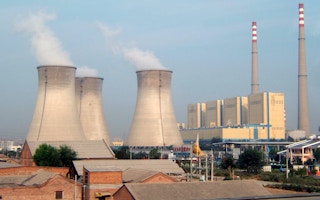China is stuck between a fossil fuel-dependent past and a future powered by renewable energy. The country today generates 53 per cent of the world’s coal-fired power. At the same time, it is the world’s leading manufacturer of, and market for, solar panels, wind turbines, and electric vehicles. Whether China can free itself from its decades-old addiction to coal will determine not just its own environmental future, but also – and more crucially – Earth’s prospects in the face of the gathering climate crisis.
China’s leaders began to recognize the need for change in the early 2000s. The largely coal-fuelled “economic growth at all costs” policy had brought great prosperity, but the collateral damage to the country’s air and water had grown unacceptably high. Environmental advocates called for “building an ecological civilisation,” in which nature and humankind would find a harmonious balance. And when President Xi Jinping assumed power in 2012, he immediately took up the cause.
In quick succession, the Chinese government declared a “war on pollution,” drew up separate air, water, and soil action plans committing US$1 trillion to environmental cleanup, closed inefficient coal plants, and invested hundreds of billions of dollars in renewable-energy development. It also made domestic manufacture and sales of electric vehicles a high priority, and devised a nationwide carbon-trading system.
Worryingly for China and the planet, that forward momentum now appears to have shifted into reverse. Coal consumption, which had decreased each year between 2014 and 2016, has since risen steadily. The same is true of carbon-dioxide emissions, which increased by 1.5-1.7 per cent even during the pandemic-induced slowdown in 2020.
China must do better. The 2019 United Nations Emissions Gap Report concluded that limiting global warming to 1.5° Celsius relative to pre-industrial levels requires reducing global emissions by 55 per cent from 2018 levels by 2030. But China added 38.4 gigawatts of new coal-fired power capacity in 2020, even as the rest of the world reduced its net capacity by 17.2 GW.
Worse, this increase is only the beginning. The Chinese government has approved construction of an additional 36.9 GW of coal-fired power capacity, bringing the total under construction today to 88 GW. And proposals to build another 158.7 GW are in the pipeline, putting the total new capacity now under consideration at 247 GW – more than the United States’ total installed amount of 233.6 GW.
There are probably more plants to come. Powerful coal and energy industry groups are pushing the government to increase China’s current total coal-power capacity of 1,080 GW to 1,200-1,300 GW over the next five years, and to as much as 1,400 GW by 2035. A Global Energy Monitor (GEM) report concludes that if China continues to expand capacity through 2035 as proposed, “its coal-power generation alone will be more than three times as large as the global limit on coal power use determined by the Intergovernmental Panel on Climate Change to keep global warming well below 2°C.”
What explains China’s apparent return to its coal-addicted ways? For starters, the protests in Hong Kong, the trade war with the US, and the coronavirus pandemic have shifted policymakers’ focus away from environmental reform. So, too, has the slowdown in China’s GDP growth and the rise in unemployment. The government has been more interested in stimulating traditional, energy-intensive industries like steel, iron, and cement, while provincial leaders have embarked on a spree of construction of coal-fired power plants.
Furthermore, the recent US-China trade war has heightened Chinese concerns about energy security, given that the country imports 70 per cent of its oil needs and 40 per cent of its gas requirements. And while China has gone all in on renewable energy, especially solar and wind, it cannot scale up these sources quickly enough to meet anticipated demand. Nor is the current electricity grid capable of transmitting this energy efficiently from China’s distant west, where most of it is produced, to high-demand areas. Coal – abundant and relatively inexpensive – seems to many a reliable, tried-and-true energy source.
Finally, it is probably not a coincidence that China’s “coal relapse” came at a time when the US was absent from the international climate scene. Whereas former US President Barack Obama and Xi found common ground in the battle against global warming, setting the stage for the 2015 Paris climate agreement, US disengagement from the issue under President Donald Trump probably weakened China’s commitment, too.
Which China will the world see in the next several years? That question is more urgent than ever in light of a recent International Energy Agency report warning that all new fossil-fuel development should be halted this year if the world is to achieve net-zero emissions by 2050 and have any hope of limiting the global temperature increase to 1.5°C.
Xi’s announcement in September 2020 that China aims to become carbon neutral by 2060 revived optimism. But hopes that the 14th Five-Year Plan (2021-25), released this March, would outline the government’s strategy for starting the decarbonization process were disappointed. And at US President Joe Biden’s climate summit in April, Xi announced that during the new Five-Year Plan, China would “strictly control” coal-fired power consumption but allow it to increase, and “phase it down” only from 2026.
This is a recklessly unambitious timetable. Climate experts at GEM, TransitionZero, and elsewhere calculate that limiting global warming to well below a “catastrophic” 2°C will require China to close 600 of its 1,082 coal plants by 2030. If they are right, China had better start turning its massive carbon ship around now.
Daniel K. Gardner, Co-Organizer of the China Environmental Group at Princeton University’s High Meadows Environmental Institute, is Professor Emeritus of Chinese History and Environment at Smith College, and the author of numerous books on China, including Confucianism: A Very Short Introduction and Environmental Pollution in China: What Everyone Needs to Know.
Copyright: Project Syndicate, 2021.
www.project-syndicate.org











